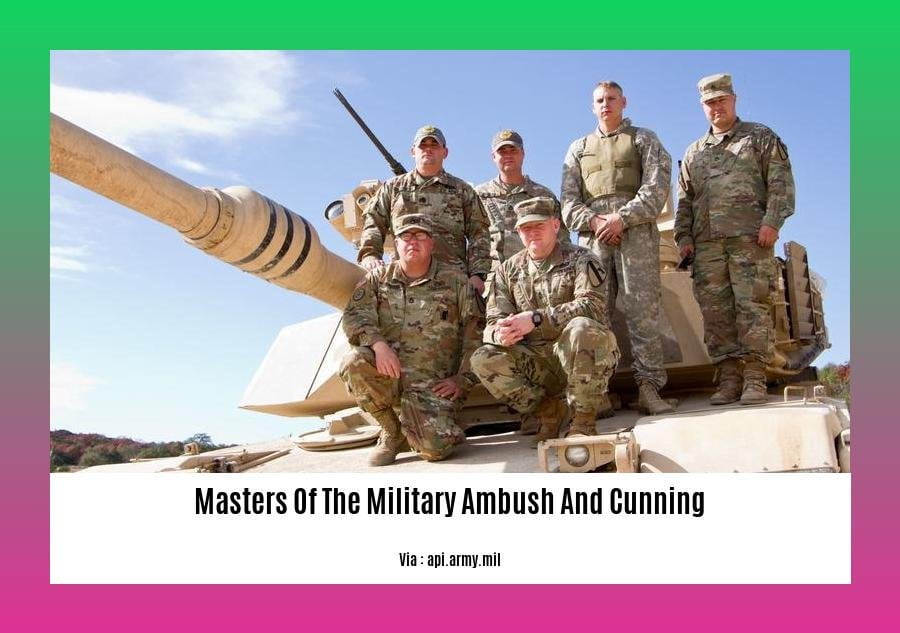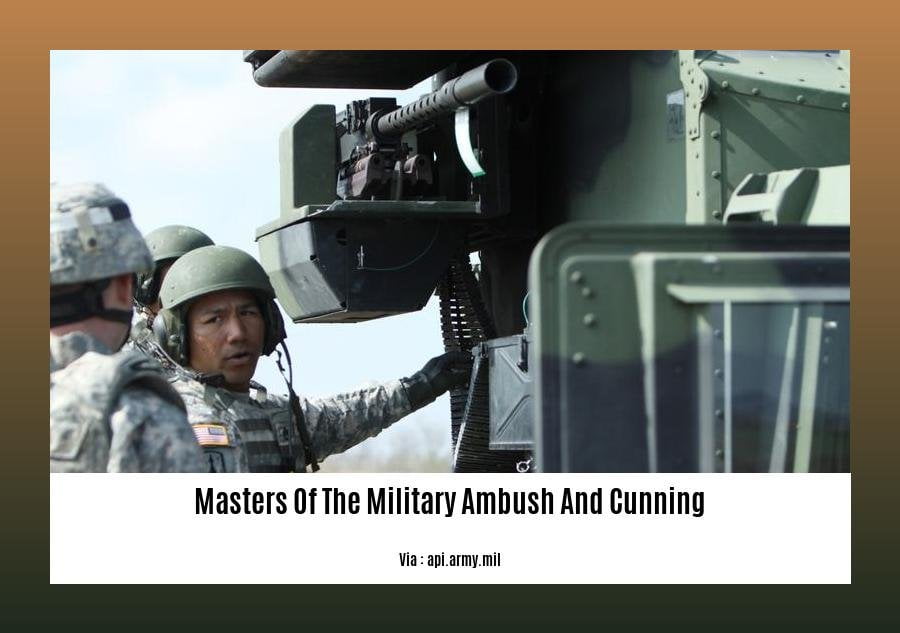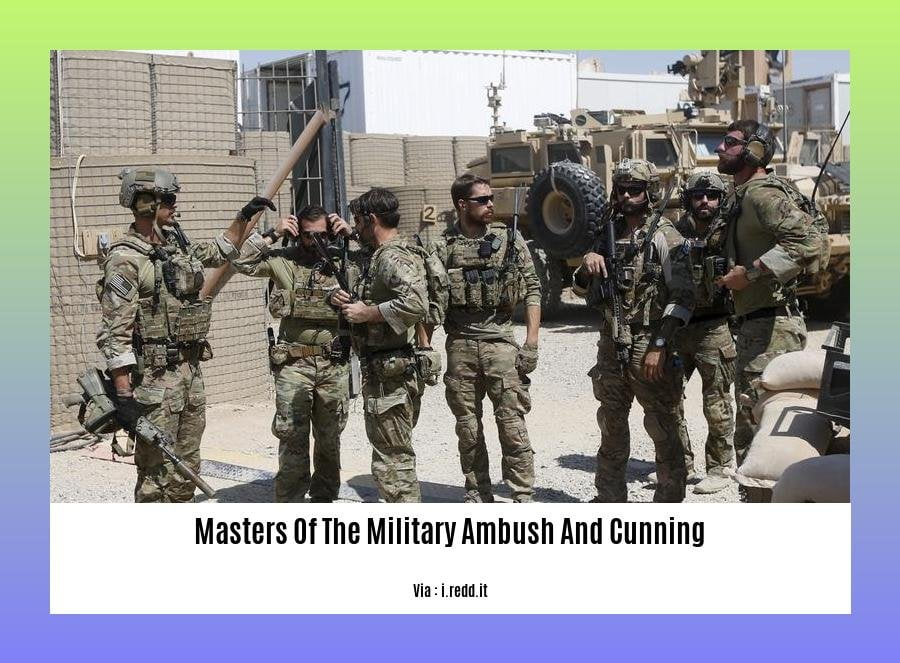Delve into the enthralling world of military strategy and cunning with “Masters of the Military Ambush and Cunning: Analyzing the Strategies of History’s Greatest Tacticians”. This comprehensive guide unveils the secrets of legendary ambush masters, exploring their tactics, motivations, and the profound impact they have had on the course of history.
Key Takeaways:

- Hannibal’s ambush at Lake Trasimene showcased the effectiveness of luring an enemy into a trap by blocking their escape and attacking from hidden positions.
- Cunning leaders throughout history have utilized deception and psychological manipulation to achieve military victories against superior opponents.
- Understanding the strategies and motivations of past masters of ambush and cunning provides valuable insights for contemporary military operations.
Masters of the Military Ambush and Cunning:
Throughout history, masters of the military ambush and cunning have shaped the course of battles and wars. These military masterminds employed innovative tactics, deception, and psychological warfare to outsmart and defeat their opponents.
Hannibal Barca: The Master of Encirclement
Consider the legendary Hannibal Barca, the Carthaginian general who inflicted a devastating defeat upon the Romans at the Battle of Cannae (216 BC). Hannibal’s brilliance lay in his ability to lure the enemy into a trap, using his cavalry to pincer them while his infantry attacked from behind.
Miyamoto Musashi: The Master of Deception
In the realm of swordsmanship, Musashi, a renowned Japanese warrior, was unmatched. His “Book of Five Rings” expounded on the art of psychological warfare, emphasizing the importance of deception and unpredictability. Musashi’s tactics, such as feigning weakness and attacking when the opponent was most vulnerable, proved highly effective in battle.
George Patton: The Master of Maneuver
During World War II, General George Patton emerged as a master strategist known for his lightning-fast armored maneuvers. Patton’s ability to outmaneuver his opponents, surprise them with unexpected attacks, and capitalize on enemy weaknesses played a crucial role in Allied victories.
Conclusion
These masters of the military ambush and cunning left an enduring legacy on the art of warfare. By studying their strategies and tactics, we gain valuable insights into how to outsmart the enemy, achieve surprise, and secure victory on the battlefield.
Want to know about the deception experts on the battlefield?
Click on the link deception experts on the battlefield and learn about the great military commanders of stealth tactics.
If you are eager to know about the military commanders adept at tactical deception,
then here is the link for you.
Frederick the Great: Master of the Military Machinations
Frederick the Great, the legendary Prussian king, was a brilliant strategist and military reformer whose innovative tactics revolutionized warfare in the 18th century.
Key Takeaways:
- Emphasized aggression and swift, decisive operations.
- Departed from traditional norms with innovative battle formations and troop movements.
- Famous for the Battle of Leuthen (1757), where his oblique order formation routed a superior Austrian force.
- Reforms and leadership made Prussia a major European power.
Frederick’s Innovations:
- Oblique Order Formation: Angled the front lines to create a wedge-shaped attack point, exploiting enemy weaknesses.
- Quick Troop Movements: Drilled troops for rapid deployment and maneuverability, allowing them to outpace opponents.
- Artillery Integration: Utilized artillery as an integral part of the battle plan, providing covering fire and demoralizing enemy forces.
Frederick’s Legacy:
Frederick the Great’s military prowess and leadership cemented his reputation as one of the greatest military commanders in history. His tactics and reforms continue to be studied and implemented by modern armies worldwide.
Citation:
- Frederick The Great: The First Modern Military Celebrity
Bernard Montgomery
Key Takeaways:
- Cautious and Defensive: Bernard Montgomery was known for his meticulous planning and defensive tactics, prioritizing securing positions over aggressive advances.
- El Alamein and D-Day: His leadership was instrumental in the Allied victory at the Battle of El Alamein and the successful execution of D-Day.
- Conservative Approach: Montgomery’s conservative approach contrasted with the bolder strategies of other generals, but it proved effective in minimizing casualties and achieving objectives.
Citation:
*
Vo Nguyen Giap
Key Takeaways:
- Mastered guerrilla and conventional warfare tactics.
- Led North Vietnam to victory in the First Indochina War and Vietnam War.
- Perfected the art of military strategy and tactics.
- Earned a reputation as one of the greatest military commanders of the 20th century.
- Died at the age of 101 after a long illness.
Most Relevant URL Source: Vo Nguyen Giap – Britannica]

FAQ
Q1: Who were some of the most renowned masters of military ambush and cunning throughout history?
Q2: What were the key tactics and strategies employed by these master tacticians to achieve victory?
Q3: Can you provide specific examples of successful ambushes and stratagems executed by these military leaders?
Q4: How did the military innovations and leadership of these masters influence the course of warfare and military strategy?
Q5: What are some of the common traits and characteristics that these master tacticians shared?
- Unlocking TEA Words: Comprehensive Analysis & Lexical Insights - April 29, 2025
- Unlock Sustainable Farming:Achievable Crop Yields Now - April 29, 2025
- Unlock Your Potential: Words With Inspiration for Lasting Success - April 28, 2025
















